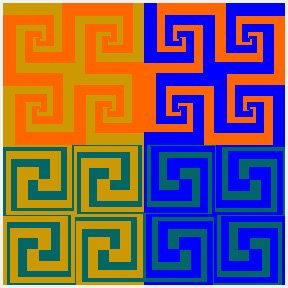
CHAN Mui Lai, - (continued) Version 2 - The same combinatorial group of 16 spirals is composed in a different manner. In each quadrant, all four spirals with the same left or right characteristic and the same plus or minus characteristic are cycled around the quadrant's center. The position of each of the four spirals, in their cyclic order, is singular, so there is no need to mark their orientations with a signal color. A central vertical R/L divider of the format separates right from left-i.e. a clockwise from a counterclockwise bias of the spiral arms. Normal to the vertical R/L divider, a horizontal +/- divider separates plus from minus-i.e., an expanding or a contracting width of the spiral arms. The resulting image might be considered analogous to four potential kinds of universes: Left-Plus, Right-Plus, Left-Minus; Right-Minus. Laws of nature lead to the theorization that only one out of the three alternative universes can exist alongside our universe: If we (arbitrarily, yet understandably) claim both Right and Plus to characterize our universe, only a Left and Minus anti-universe would be in accord with it. By the choice of strongly contrasting colors, the figuration of the Right-Plus quadrant (our universe) stands out the most among the four; by the contrast of colors given the Left-Minus quadrant (the anti-universe), its figuration is the second most evident; in the other two quadrants (the two improbable universes), the figurations, equally diminished in their color contrasts, appear as "apparitions", far fainter in respect to the "known" universe and its associated anti-twin. |